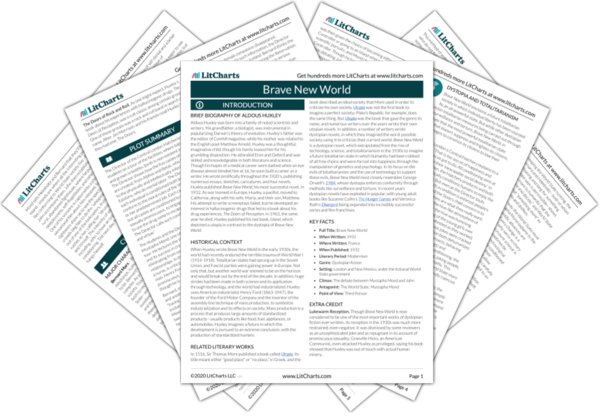Welcome to the LitCharts study guide on Aldous Huxley's Brave New World. Created by the original team behind SparkNotes, LitCharts are the world's best literature guides.
Brave New World: Introduction
Brave New World: Plot Summary
Brave New World: Detailed Summary & Analysis
Brave New World: Themes
Brave New World: Quotes
Brave New World: Characters
Brave New World: Symbols
Brave New World: Literary Devices
Brave New World: Theme Wheel
Brief Biography of Aldous Huxley

Historical Context of Brave New World
Other Books Related to Brave New World
- Full Title: Brave New World
- When Written: 1931
- Where Written: France
- When Published: 1932
- Literary Period: Modernism
- Genre: Dystopian fiction
- Setting: London and New Mexico, under the fictional World State government
- Climax: The debate between Mustapha Mond and John
- Antagonist: The World State; Mustapha Mond
- Point of View: Third Person
Extra Credit for Brave New World
Lukewarm Reception. Though Brave New World is now considered to be one of the most important works of dystopian fiction ever written, its reception in the 1930s was much more restrained, even negative. It was dismissed by some reviewers as an unsophisticated joke and as repugnant in its account of promiscuous sexuality. Granville Hicks, an American Communist, even attacked Huxley as privileged, saying his book showed that Huxley was out of touch with actual human misery.
The Doors of Rock and Roll. As one might expect, Huxley's book about his experiences with hallucinogenic drugs, The Doors of Perception, was a cult classic among certain groups. One of those groups was a rock and roll band in search of a name. After Jim Morrison and his friends read Huxley's book, they had one: The Doors.







